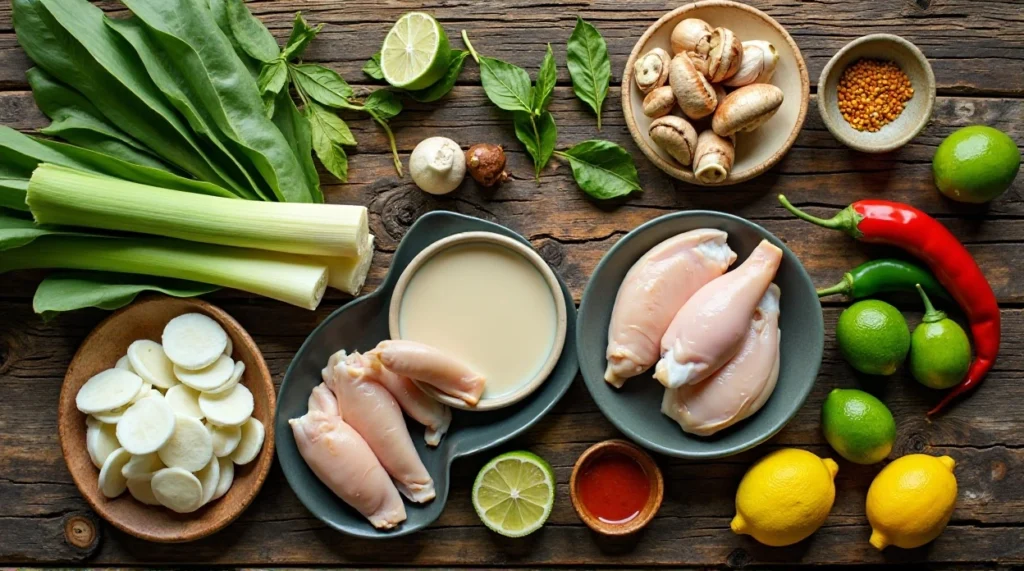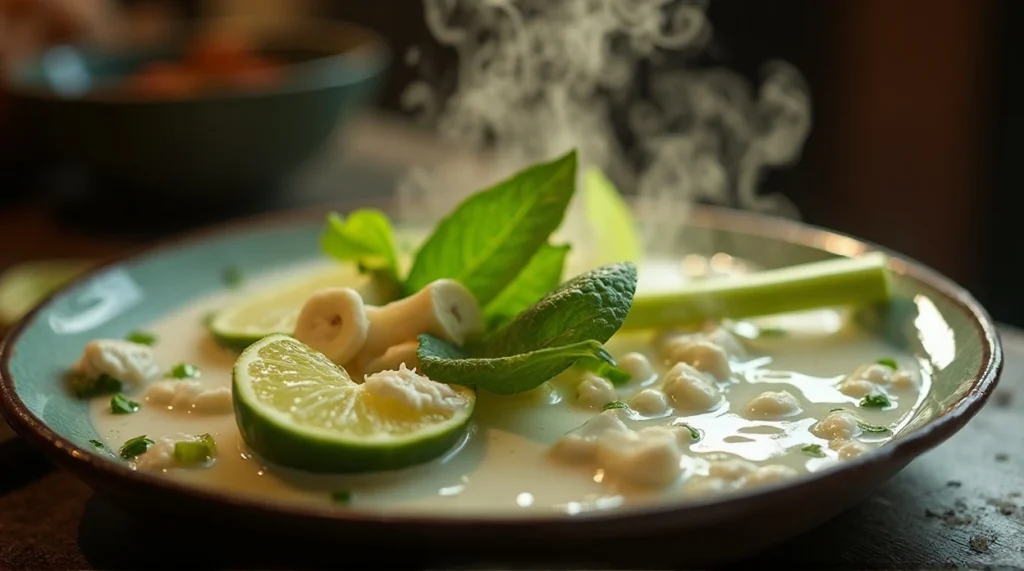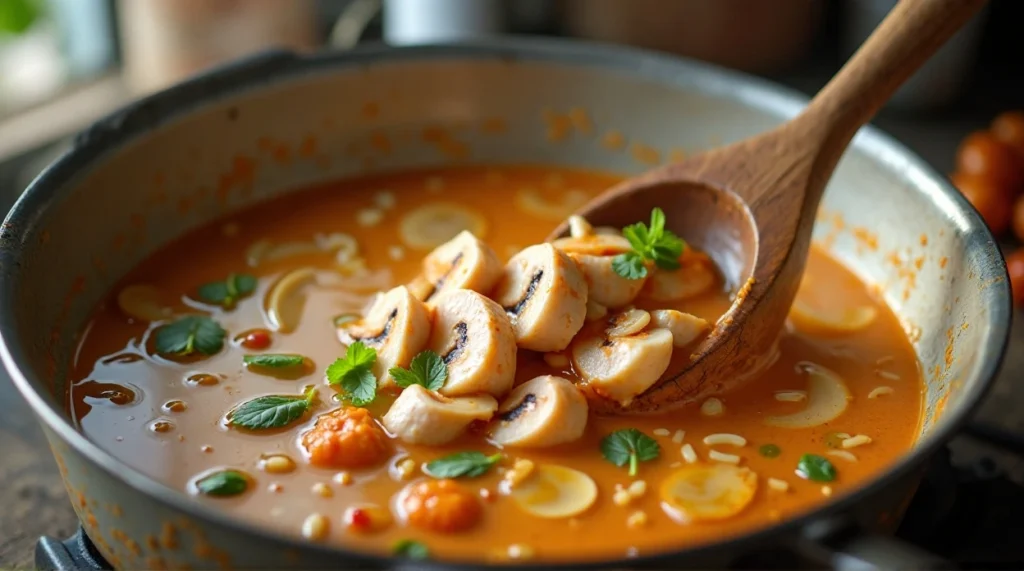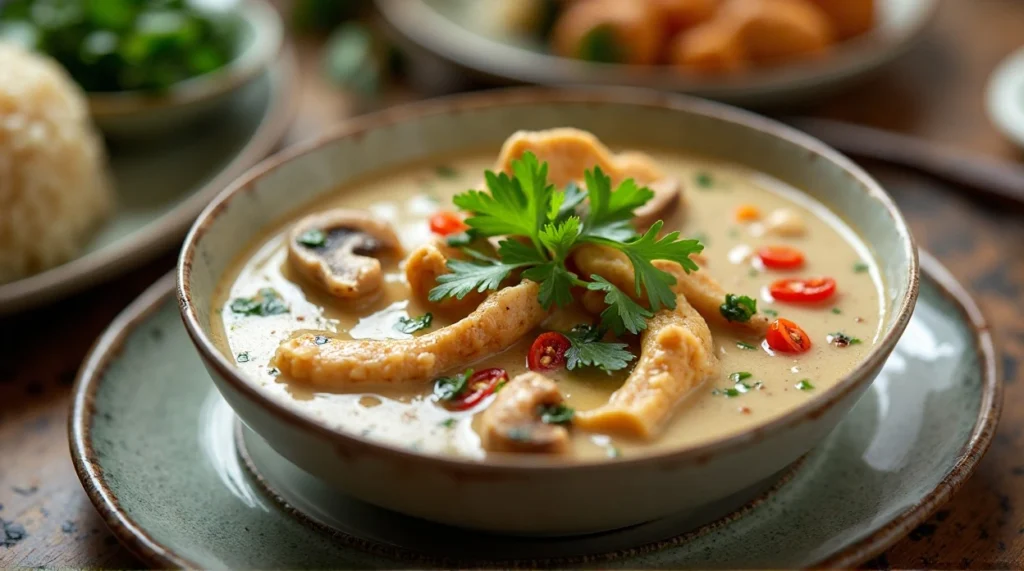Tom Kha Gai – Authentic Thai Coconut Chicken Soup Recipe
Have you ever tasted something so comforting that it instantly transported you somewhere else? That’s what Tom Kha Gai does. The moment you take your first spoonful, you feel the silky coconut broth coat your mouth, followed by the sharp zest of lime and the earthy kick of galangal. It’s not just a dish—it’s a story, a tradition, and a piece of Thailand you can bring into your own kitchen.
By the end of this guide, you’ll know how to prepare Tom Kha Gai authentically, understand the balance of flavors that makes it unique, and learn the little secrets that turn a good soup into an unforgettable one.
Table of Contents
What is Tom Kha Gai?
At its core, Tom Kha Gai is a Thai coconut chicken soup. “Tom” means soup, “Kha” refers to galangal (a root that looks a bit like ginger but tastes sharper and more citrusy), and “Gai” means chicken.
This dish originated in central Thailand and has since become a global favorite. Unlike the fiery Tom Yum soup, Tom Kha Gai is milder, creamier, and comforting without losing its bold, layered flavors.
You’re not just making soup—you’re creating a balance of sweet, sour, salty, and spicy that Thai cuisine is famous for.
Key Ingredients You’ll Need
The magic of Tom Kha Gai lies in its ingredients. Each one contributes something essential, so whenever possible, stick to the authentic components.
Traditional Base Flavors
- Coconut milk – Rich, creamy, and the soul of this soup.
- Galangal – Gives the sharp citrus-pepper punch. Don’t swap it with ginger if you want the real thing.
- Lemongrass – Adds a fresh, lemony fragrance.
- Kaffir lime leaves – Their unique aroma can’t be replicated with regular limes.
Protein and Vegetables
- Chicken (boneless thigh is best for tenderness).
- Mushrooms (straw mushrooms traditionally, but button mushrooms work too).
- Optional: cherry tomatoes for sweetness, chili peppers for heat.
Essential Seasonings
- Fish sauce for salty depth.
- Lime juice for the sour bite.
- Thai chili paste (Nam Prik Pao) for smokiness and spice.
Ingredient Table for Tom Kha Gai (4 servings)
| Ingredient | Quantity | Notes |
|---|---|---|
| Chicken thighs | 400 g | Thinly sliced |
| Coconut milk | 2 cups | Full-fat for best results |
| Galangal | 5–6 pcs | Fresh preferred |
| Lemongrass stalks | 2 | Bruised to release oils |
| Kaffir lime leaves | 4–5 | Tear to release aroma |
| Mushrooms | 200 g | Straw or button mushrooms |
| Fish sauce | 2–3 tbsp | Adjust to taste |
| Lime juice | 2–3 tbsp | Add at the end |
| Thai chili paste | 1–2 tbsp | Optional but recommended |
| Fresh chilies | 2–3 | For heat (optional) |




Step-by-Step Guide: How to Make Tom Kha Gai
Step 1 – Build the Broth
Pour your coconut milk into a pot and bring it to a gentle simmer. Add galangal, lemongrass, and kaffir lime leaves. Let them infuse slowly—you’ll smell the aroma long before you taste it.
Step 2 – Add the Chicken
Slip the chicken slices into the broth. Cook gently until the meat turns opaque and tender. Avoid boiling too hard; this keeps the chicken juicy.
Step 3 – Balance the Flavors
Add mushrooms, chili paste, fish sauce, and finally lime juice. Adjust until you strike the sweet spot of creamy, tangy, salty, and spicy.
Step 4 – Garnish and Serve
Top with cilantro or green onion. Serve piping hot with jasmine rice for a meal that feels complete.
Tips for Authentic Flavor
- Stick with galangal, not ginger—it makes or breaks authenticity.
- Always use full-fat coconut milk; light versions turn the broth thin and bland.
- Add lime juice at the very end to prevent bitterness.
- Adjust spice gradually—you can always add more, but you can’t take it away.
Variations of Tom Kha Soup
You can adapt this soup without losing its charm:
- Vegetarian Tom Kha: Use tofu and soy sauce instead of chicken and fish sauce.
- Seafood Tom Kha: Shrimp or fish adds a briny depth.
- Mild Version: Reduce the chilies for a gentler flavor.
Nutritional Benefits
Tom Kha Gai isn’t just tasty—it’s nourishing.
- Coconut milk provides healthy fats.
- Galangal and lemongrass are known for their anti-inflammatory properties.
- Chicken offers lean protein.
- Without rice, it’s naturally low-carb.
Nutrition Table (per serving, approx.)
| Calories | Protein | Fat | Carbs |
|---|---|---|---|
| 320 | 25 g | 18 g | 10 g |
Serving Suggestions
Your Tom Kha Gai deserves the right partners:
- Serve with steamed jasmine rice or sticky rice.
- Pair with Pad Thai or Thai green curry for a full Thai feast.
- Garnish with chili oil, fried shallots, or cilantro for extra flair.
Common Mistakes to Avoid
Even the best cook can stumble if you overlook these:
- Boiling too hard: Coconut milk separates.
- Adding lime juice early: It turns bitter.
- Swapping ginger for galangal: The flavor won’t be authentic.
- Skipping kaffir lime leaves: You lose the signature fragrance.
Conclusion
Cooking Tom Kha Gai is more than following steps—it’s about capturing the harmony of Thai cuisine in a bowl. With its creamy coconut base, tangy lime notes, and fragrant herbs, it brings a taste of Thailand right to your table. Once you master it, you’ll never look at soup the same way again.
So, gather your ingredients, follow this guide, and enjoy a dish that’s both authentic and heartwarming.
FAQ – Tom Kha Gai
What does Tom Kha Gai mean?
It literally translates to “soup with galangal and chicken.”
Can you freeze Tom Kha Gai?
Yes, though the coconut milk may separate slightly—reheat gently.
Is Tom Kha Gai spicy?
It can be mild or fiery depending on how many chilies you use.
What’s the difference between Tom Kha Gai and Tom Yum?
Tom Yum has a clear, spicy broth. Tom Kha Gai is creamy and slightly milder.
Can it be made vegetarian?
Yes, substitute chicken with tofu and fish sauce with soy sauce.
Now it’s your turn—head to your kitchen, gather those aromatic Thai ingredients, and cook up your own pot of Tom Kha Gai. When you taste that first spoonful, you’ll understand why this soup has won hearts worldwide.
If you try this recipe, share your experience in the comments, and let’s celebrate the joy of authentic cooking together.




